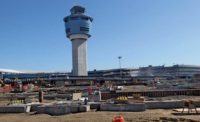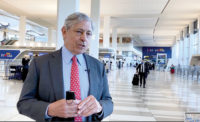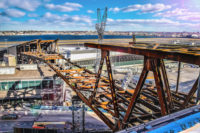The placement of the second of two pedestrian bridges 60 ft above an active airfield last month marked the final piece of significant construction for the new $5.1-billion Terminal B at LaGuardia International Airport. Demolition of the old terminal is now underway as the largest U.S. aviation project under a public-private partnership stays on track for an on-time completion late this year.
The 482-ft-long western pedestrian bridge and the 440-ft-long eastern bridge, both 2,500 tons, are the first of their kind and opened up two miles of new taxiway space, says Jane Garvey, former Federal Aviation Administration leader and currently chair of Meridiam. The firm—along with Vantage, Skanska and JLC Infrastructure—comprises LaGuardia Gateway Partners, the development and equity investment team. Skanska Walsh is the design-build joint venture. HOK and WSP led design.
The increased airfield space was made possible by the “island” concourse design, says Rick Cotton, executive director of the Port Authority of New York and New Jersey. “The new terminal is about 600 feet closer to the Grand Central Parkway than the old one,” he notes. “The gates go 360 degrees around the central concourse. Passengers go over the skyway bridges that lead from the departures hall to the island concourses and vice versa. Any airplane at a gate always has one of two ways to enter or depart. If an aircraft is blocking one portion of the taxiway, [the parked airplane]can access the gate in the other direction since the concourse is circular. This dramatically reduces gate delays.”
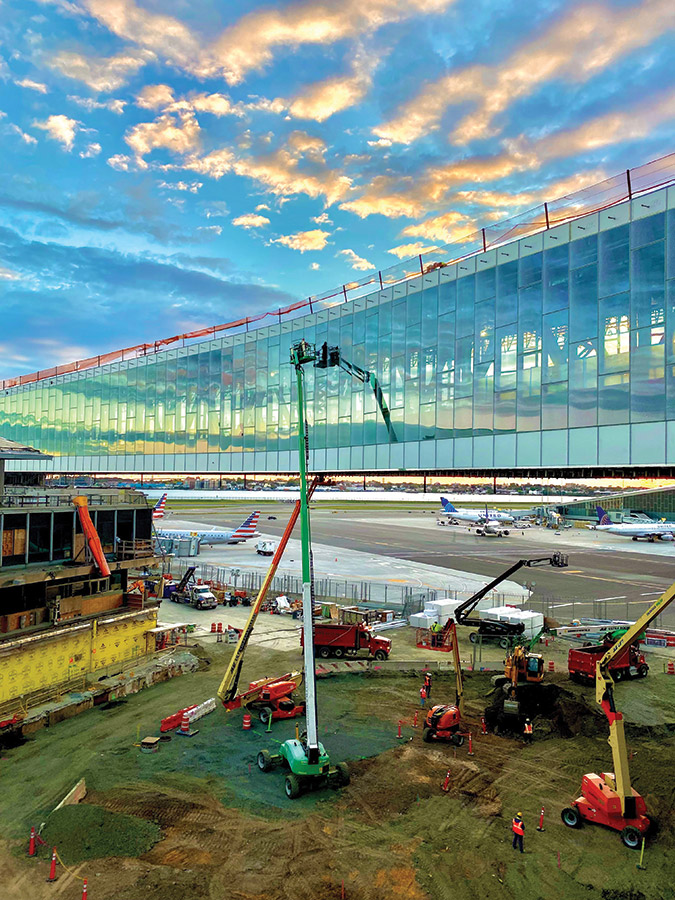
Two pedestrian bridges soar over taxiways.
Photo courtesy LGP
Crews built the departure hall section of the 1.3-million-sq-ft terminal using a temporary 33-ft-high, 200,000-sq-ft steel “dance floor” that increased safety for workers on the ground, says Bryant M. Farland, regional executive officer with Skanska USA Building Inc. “We suspended a floor from the ceiling 10 feet below to perform all the overhead work—from drywall to lighting and mechanical work,” he says. “The dance floor then allowed us to work at the ceiling without introducing multiple [pieces of lifting equipment].” That was one of the safety-related measures that enabled 17 million people-hours worked without any major incidents.
Regarding the pandemic, the “postage-stamp” footprint of LaGuardia never changed, so crews didn’t have the silver-lining advantage of extra space due to shutdowns, Farland notes. “We were on the frontline of figuring out how you can operate during a pandemic. We were on the bleeding edge of temperature checks and constantly relooking at protocols.”
“I see real potential [for p3s]—transit in particular.”
— Jane Garvey, Global Chair, Meridiam
The design-build team had to maintain 33 active gates during construction of the terminal, which includes 151 miles of fiber-optic cable. “We believe this is the largest run of passive network anywhere in the country for a commercial airport,” says Farland.
The main structural steel elements of the two skybridges were factory assembled to ensure proper fit and geometry and delivered to the site. “Once we confirmed that everything worked—design camber, width, length—all truss sections were surveyed and then final erection and release of the camber occurred over several months,” says Farland. “The various truss elements were defined in tight segments and set on all these pre-engineered shoring towers to replicate exactly the factory assembly.”
The eastern bridge, set in place in 2018, had an apron for a staging area, but the western bridge did not, says Farland. “It was a just-in-time delivery approach and a 24-hour operation.”
The project team coordinated nearly 30 separate 3D design models and used 360° photography and laser scanning to limit clashes, changes and guesswork. Once the project got under way, material and production tracking recorded field productivity, enabling the project team to stay ahead of potential schedule conflicts. The team had to coordinate around-the-clock deliveries and installation of massive structural steel elements totaling nearly 40,000 tons. Cranes were precisely positioned to prevent them from obstructing air traffic controllers’ line-of-sight of the airfield.
Crews have begun demolishing the existing Terminal B and will complete construction of 8 miles of roadway, 20 bridges and landscaping, says Cotton. The biggest milestone of all “was to complete every square inch of the new passenger facility,” he adds. “It means that every single passenger arriving or departing will utilize a new gate, pass through only new 21st-century facilities, and only experience the bright natural light-filled spaces, public art, concessions and state-of-the-art check-in facilities. The processing capacity is more than 50% [larger] than in the old terminal.”
An adjacent $4-billion new terminal for Delta Air Lines also is well on its way to completion, with “a major opening of the arrivals/departures hall this spring,” says Cotton. “With that, the final pieces of roadway will also fall into place. We’ll be tearing down all old facilities in the next few months.”
The concessionaire will operate the terminal through 2050.
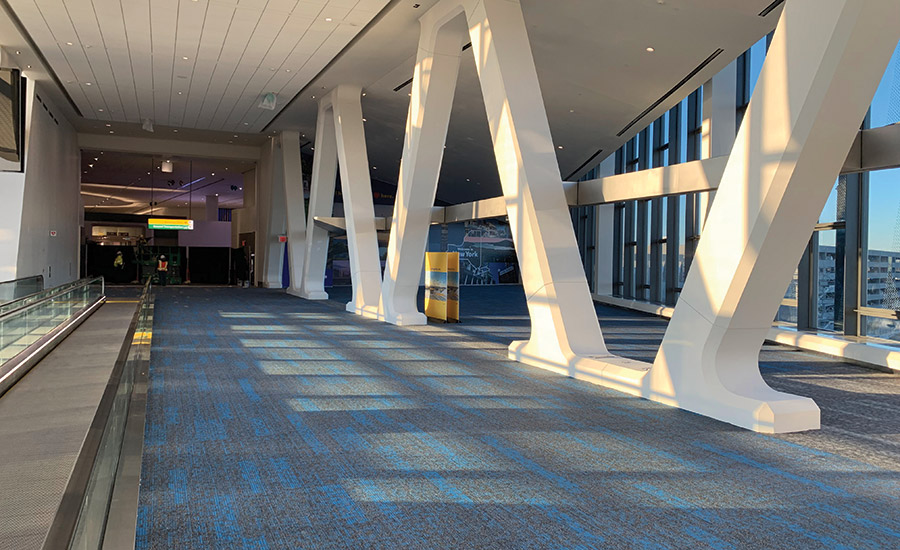
Photo courtesy LGP
Innovative Delivery
Garvey says that innovative project delivery proved beneficial from the start, with the design-build team able to scale down an original construction schedule of seven phases to five.
"The Port believed the P3 model would bring additional private sector expertise and innovation to the project,” she says.
The complexity of the Terminal B project, the encroachment of a bond cap and the need to fund other projects made P3 an appropriate model.
Regarding the sharing of risk, “the concessionaire and contractor assumed the construction and financial risk, while the Port addressed the early environmental issues and was a full partner throughout the project,” Garvey says.
Vantage will draw on its LaGuardia P3 experience to lead JFK Millennium Partners, which will develop a $3.9-billion, 1.2-million-sq-ft terminal at John F. Kennedy International Airport for JetBlue. Construction of the new terminal is scheduled to begin later this year, with the first gates to open in 2025, according to Vantage.
Garvey concurs that P3 potential is ripe for future airport facilities. “I also see real potential on the surface side—transit in particular.”



